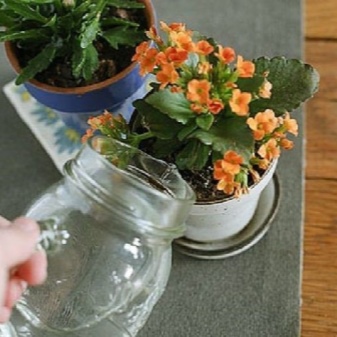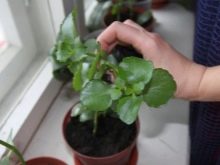Kalanchoe Blossfeld: what features are different and how to care for it?

The evergreen succulent was first described by Camel at the beginning of the last century. The name of the culture was taken from the Chinese language. Another name for the culture is Christmas Kalanchoe, associated with the color of the buds that bloom in the winter before Christmas. The plant is common as a home flower in many countries.
Description
Kalanchoe Blossfeld comes from the fat family. The culture got its name from the breeder Robert Blossfeld. The plant was first introduced in 1932.
Appearance: erect shrub, the average flower height is 30 cm with an abundance of short branchy shoots. The leaf plates are large, green, smooth, the edges are curved, some varieties have a red border. The color of the buds of the wild culture is bright red.
Kalanchoe flowers are small, collected in inflorescences, from 30 to 60 buds. With the help of selection, varieties have been bred with various colors of flowers of any saturation: white, orange, pink, yellow, peach, light green, two-color, variegated combinations.






Under natural conditions, the culture is common in Madagascar; houseplants are grown for their decorative qualities. Individuals obtained by breeders have large foliage, the number of petals varies from four to tens. New groups of Kalanchoe became known as Kalandiva. This variety, unlike Blossfeld, blooms for two and a half months.
Kalanchoe is used as a medicinal plant in folk medicine, its juice is used as a healing agent for burns, various damage to the outer layers of the skin. In modern medicine, this type of culture is practically not used and is not officially recognized as a therapeutic agent.


Care
At home, culture is subject to slow development. To form a compact plant, obtain abundant flowering and preserve the decorative effect of the flower, the Kalanchoe should be properly looked after. The main points of care are to observe the number of hours of daylight hours and adjust the watering of the plant.
Lighting
South-facing windows are suitable for growing Blossveld Kalanchoe. When placed on the west, east and north side, the crop will need an additional light source. In dry hot seasons, the plant needs ventilation and temporary shading from the scorching rays.
Changing the length of daylight affects the process of setting flower buds. Kalanchoe refers to short-day crops, therefore, the plant needs a series of long and short days throughout the year to form buds. Some varieties need a short period and vice versa. On average, a flower needs 10 hours of light per day for 6 weeks; at the end of the period, the inflorescences will become visible. An increase in the length of the day leads to a compact formation of a bush, abundant flowering.
In summer, the flower needs 14 hours of light for 6 weeks. However, elevated temperatures can have a negative effect on the plant, including the setting of flower buds.

Temperature
Suitable for the growth and development of culture, the air temperature fluctuates around 18-24 degrees Celsius. The plant enters a dormant period at low temperatures, ceasing to form buds.If you stay in a room for a long time, where the air is warmed up to +10 degrees, the flower is susceptible to diseases and may even die.
Humidity
The culture is adapted to dry air, but for preventive purposes it is recommended to wet the leaves and stems of the flower 1-2 times a week.
Watering
Kalanchoe Blossfeld calmly tolerates dry substrate, like all succulents. An excessive amount of moisture in the soil leads to the development of a fungus, decay of the roots, stems and the neck of the plant. Watering is recommended as the soil dries up at least half or a quarter; in the winter months, when the culture is kept cold, watering the plant is rarely done, only after the earthen coma has completely dried out.


Fertilizer
During the flowering period (from winter to summer), the Kalanchoe must be fertilized. Feeding the flower is carried out in small doses once a week, special soluble preparations are used for Kalanchoe or succulents. At the time of bud formation, nitrogen-containing fertilizers are not used, the flowers require potassium and phosphorus.

Pruning
After the end of the flowering period, it is required to remove all wilted and dry peduncles. The cut is made at the level of the first or second pair of large leaves. Further growth of the shoot ends in the formation of a peduncle, the lateral shoots growing from the leaf axils form new apical peduncles.
Older plants require a formative pinch. The tops are mainly pinched to stimulate the bookmark of peduncles, active branching.
Modern Kalanchoe varieties enter the market already formed and do not need such manipulation.

The lack of a sufficient amount of light leads to the loss of compactness of the bush, decorative effect and elongation of shoots with a drooping effect. In this case, a radical pruning of the culture is performed, the leaves are removed, and the shoots are cut half the length or more. After the procedure, the plant is placed in a bright place, the cut material goes for rooting.
On an industrial scale, cultivation of Kalanchoe to preserve the presentation of the plant, inhibitory preparations are used that suppress the growth of the flower, due to which the culture turns out to be compact and abundantly flowering. Under normal conditions, the plant grows tall, the gaps between the leaves increase.


Transfer
The plant is transplanted after the soil mixture is completely entwined with the roots, as well as in cases of flooding of the culture or old scarce soil. In the first variant, the Kalanchoe is transplanted by the transshipment method, that is, without removing the soil. A nutrient mixture is poured into a new pot, several centimeters wider than the old one, and a planting pit is formed in the center, in which the plant is placed.
In other cases, it is also not recommended to rinse the substrate and roots during the transplantation of the culture if the plant has not been infected with fungus and other diseases. The frequency of transplantation depends on the age of the Kalanchoe and its condition; on average, the process of changing the pot occurs every 2-3 years.

Reproduction
Kalanchoe can be propagated in two ways: by seeds and cuttings taken from a leaf or stem of a plant. The second method is faster.
Apical cuttings are placed in the shade for 24 hours before planting. After that, the fragment is immersed in a loose substrate composed of a mixture of peat and sand. Proportions 1: 1. Sprinkle the cuttings and topsoil with warm water. The finished material is placed in a warm place with a constant temperature of +20 degrees. A deviation of several degrees is possible, the main thing is that there are no sudden temperature jumps. Roots appear in 2-3 weeks.
Leafy cutting. The leaf is harvested from an adult plant; a large, juicy, defect-free fragment is selected. The workpiece is placed cut down in a wet substrate in greenhouse conditions. Root emergence occurs after a few weeks.

Seed propagation is used in the creation of new varieties and the renewal of old ones. Kalanchoe seeds are small, sown on a prepared soil mixture in rows without sprinkling on top. After sowing, the container with the material is covered with a film or any transparent object to create a greenhouse effect and placed in a lighted place, without contact with direct sunlight. The emergence of sprouts occurs on day 10, after which the greenhouse is removed.

Important: if seed propagation is carried out in winter or autumn, the future culture is placed under phyto-lamps. The seeds should be lit 12 hours a day.
Pests and diseases
The causes of diseases in most cases are associated with improper crop care. Keeping a flower under conditions of short daylight hours or with constant shady placement leads to damage by powdery mildew, which manifests itself in the form of a white bloom, similar to grains of flour. Powdery mildew is a fungus, to combat which the culture is treated with liquid-soluble preparations - fungicides and the flower is sent to quarantine.
Staying Kalanchoe in cool conditions in a damp room or with flooded soil leads to the appearance of mold, phytophthora, and decay of the root system. As in the case of powdery mildew, the culture should be treated with a substance containing a fungicide, a complete replacement of the substrate with a new one, followed by treatment of the affected roots with the use of coal or healing preparations.
Common Kalanchoe pests:
- mealybug;
- shield;
- aphid.



The scale insect is a small brown insect that feeds on plant sap. In the process of its vital activity, the surfaces of the flower are covered with a sticky transparent coating, and the leaves and shoots are dotted with tiny bugs.
Aphids infect the plant during the warm summer period, when the culture is placed near an open window or on a balcony. Insects are attracted by the nutrient soil. Signs of aphids:
- the inside of the leaf is covered with small white flying "butterflies";
- on leaf plates and shoots "wet" places are formed - traces of feeding of aphids.
The mealybug is an insect that looks like a scale insect, but with a white dusty back. It affects all ground parts of the plant, leaving behind a sugary discharge, on which a sooty fungus develops.
Prevention and treatment of a flower from pests consists in a systematic examination of the culture for the presence of strange spots, sticky zones, and moving insects. When an ailment is detected, Kalanchoe is treated with insecticidal preparations in several stages, and the earthen mixture is replaced.
For all therapeutic manipulations, it is recommended to use water-soluble preparations due to the content of xylene in insecticides, which can negatively affect Kalanchoe.



The non-infectious diseases affecting the culture include dropsy. It occurs due to the content of the flower in cool conditions with simultaneous waterlogging of the soil. The leaf plates are covered with convex brown spots, similar to warts. To treat dropsy by replacing the soil and placing the culture in a warm, bright place. Watering needs to be adjusted.
Alkalization of the soil leads to deformation of young leaves, their poor growth and development, loss of color. The earth should be spilled with soft water with the addition of acidic substances, for example, a few drops of lemon juice per liter of liquid.


For tips on caring for Blossfeld's Kalanchoe, see the video below.



















































The comment was sent successfully.